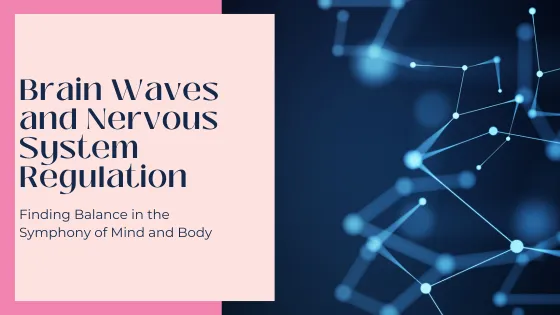
Brain Waves and Nervous System Regulation: Finding Balance in the Symphony of Mind and Body
In my path to understanding brain waves and their connection to the intricate network of our nervous system, I learned quite a lot about the fascinating world of brain waves, their significance in our mental and emotional states, and practical tips for regulating our nervous system.
[disclaimer: I'm not a neuro-scientist, all the information shared here is based on my personal research and opinions]
Understanding Brain Waves: The Symphony of Consciousness
Our brains generate electrical patterns known as brain waves, which reflect the rhythmic activity of billions of neurons communicating with one another. These brain waves can be categorized into different frequencies, each associated with distinct mental and emotional states. Here are the primary brain wave states:
Gamma Waves (above 30 Hz): Gamma waves are the fastest brain waves and are associated with heightened perception, problem-solving, and moments of intense focus and concentration. They are often observed in advanced meditators, creative individuals, and peak performance states.
Beta Waves (13-30 Hz): Beta waves are associated with our waking, active states of consciousness, characterized by alertness, focused thinking, and problem-solving. They dominate during our daily activities and engagement with the external world.
Alpha Waves (8-12 Hz): Alpha waves are present when we experience a relaxed yet alert state of mind. They are associated with a calm, meditative state, creative insights, and daydreaming. Alpha waves often emerge when we close our eyes, engage in relaxation techniques, or engage in creative endeavors.
Theta Waves (4-7 Hz): Theta waves are associated with deep relaxation, daydreaming, and the early stages of sleep. They are often present during deep meditation, hypnosis, and moments of insight or inspiration. Theta waves play a vital role in accessing the subconscious mind.
Delta Waves (0.5-3 Hz): Delta waves are the slowest brain waves and are associated with deep sleep, unconsciousness, and the body's restorative processes. They play a crucial role in physical and mental rejuvenation.
The Nervous System and Brain Waves: Partners in Harmony
Our brain waves and the nervous system share a close and interconnected relationship. The nervous system comprises the central nervous system (brain and spinal cord) and the peripheral nervous system (nerves spread throughout the body). It acts as a sophisticated communication network, allowing the brain to send and receive signals to different parts of the body.
Brain waves are a reflection of the electrical activity within the brain, while the nervous system acts as a conduit for transmitting these signals throughout the body. The balance and synchronization of brain waves are closely tied to the state of our nervous system. When our nervous system is in a balanced state, it supports optimal brain wave patterns and facilitates overall well-being.
Nervous System Dysregulation: Understanding the Triggers
The nervous system can become dysregulated due to various factors, including:
Stress and Trauma: High levels of stress or exposure to traumatic experiences can overwhelm the nervous system, leading to dysregulation. This can result from a single traumatic event or accumulated stress over time.
Chronic Stress: Prolonged periods of stress, such as ongoing work pressure, relationship difficulties, or financial worries, can disrupt the balance of the nervous system.
Environmental Factors: Certain environmental factors, such as noise pollution, bright lights, or an excessively busy schedule, can overstimulate the nervous system and contribute to dysregulation.
Unresolved Emotions: Suppressed or unprocessed emotions, such as grief, anger, or fear, can impact the nervous system's functioning and lead to dysregulation.
When the nervous system becomes dysregulated, it can manifest in various ways, including heightened anxiety, chronic fatigue, irritability, difficulty concentrating, sleep disturbances, and physical symptoms like headaches or digestive issues.
Flight, Fight, Freeze, and Fawn: Responses to Threat
When faced with a perceived threat or danger, the nervous system triggers instinctual responses known as the "fight-flight-freeze-fawn" responses. These responses have evolved as survival mechanisms to protect us from harm. Here's a brief explanation of each response:
Flight: The flight response prepares us to flee from a perceived threat. It activates the sympathetic nervous system, leading to an increase in heart rate, rapid breathing, and heightened alertness, preparing us for escape.
Fight: The fight response prompts us to confront and combat a threat. It triggers a surge of energy, increased strength, heightened focus, and a readiness to defend ourselves.
Freeze: The freeze response occurs when the nervous system perceives overwhelming danger or a lack of escape options. It involves a temporary immobilization response, where the body becomes still, and cognitive processing may slow down. This response is often seen in situations where escape or confrontation is not feasible.
Fawn: The fawn response is a social survival strategy. It involves seeking safety and avoiding harm by complying with others' demands or attempting to appease and please them. It is often observed in situations where the individual feels powerless or vulnerable.
It's important to note that these responses are automatic and instinctual, and they serve as protective mechanisms. However, in cases of chronic stress or trauma, these responses can become dysregulated, leading to ongoing challenges in daily life.
Understanding these responses can help individuals recognize their own reactions and develop strategies to regulate their nervous system and promote a sense of safety and well-being.
Tips for Nervous System Regulation: Cultivating Balance and Resilience
Mindful Breathing: Deep, diaphragmatic breathing activates the parasympathetic nervous system, promoting relaxation and reducing stress. Practice slow, rhythmic breathing throughout the day to regulate your nervous system.
Meditation and Mindfulness: Engage in regular meditation or mindfulness practices to calm the mind, reduce anxiety, and promote a balanced nervous system. Focus on the present moment, observe your thoughts without judgment, and cultivate inner stillness.
Physical Exercise: Engaging in regular physical activity supports nervous system regulation by releasing endorphins, reducing stress hormones, and promoting overall well-being. Find activities that you enjoy, such as walking, yoga, or dancing, and incorporate them into your routine.
Healthy Lifestyle Habits: Prioritize a balanced diet, adequate sleep, and healthy lifestyle habits. Nourishing your body with nutritious food, getting enough restorative sleep, and avoiding excessive stimulants can significantly impact your nervous system's equilibrium.
Stress Management: Implement stress management techniques such as journaling, practicing gratitude, engaging in hobbies, or seeking support from loved ones. Find healthy ways to cope with stress and promote a sense of emotional well-being.
By incorporating these practices into your daily life, you can cultivate a balanced nervous system, optimize your brain wave patterns, and experience a greater sense of calm, focus, and overall wellness.
In Harmony with Mind and Body
Understanding the dynamic relationship between brain waves and the nervous system empowers us to take an active role in our well-being. By nurturing a balanced nervous system through mindful practices, we can create a harmonious symphony between our minds and bodies.
Wishing you tranquility and vibrant well-being on your journey of nervous system regulation. If you need support during this journey, you might want to consider joining the Money Mindset Mastery program - we cover a lot of resources that support this experience.
© GIGIBIER.COM | ALL RIGHTS RESERVED | TERMS & CONDITIONS | Privacy policy | SITE BY FUNNEL GORGEOUS

